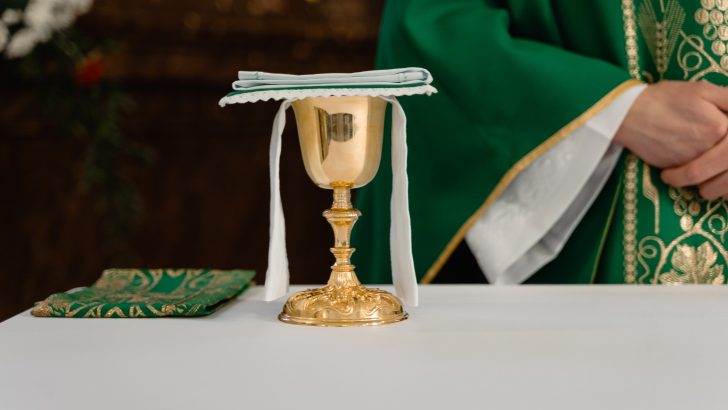Q: I’ve often wondered why Catholics emphasise the Eucharist more than the wine, as the wine is not offered at Communion time. Jesus said to do both in remembrance of him. Isn’t it wrong to not receive both as Jesus taught?
A: First, the Eucharist is both the bread that becomes the body of Christ and the wine that becomes his blood. Usually after the bread has been consecrated – that is, changed into the body of Christ – we refer to it as the ‘host’ to reflect the fact that despite outward appearances it is no longer bread; similarly, we refer to the wine after it is consecrated as the ‘precious blood’ or we might refer to ‘drinking from the chalice’. In more technical terms, we might also refer to both together as ‘the sacred species’ or speak of ‘receiving communion under both kinds’.
The Church has a teaching called the doctrine of concomitance, which holds that both Eucharistic species are fully consecrated, and that receiving Communion under either kind means that we are receiving Jesus fully in his body, blood, soul and divinity. That is, we are not receiving ‘less Jesus’ when we receive under only one kind.
As we read in Paragraph 1390 of the Catechism of the Catholic Church: “Since Christ is sacramentally present under each of the species, Communion under the species of bread alone makes it possible to receive all the fruit of Eucharistic grace.”
This same paragraph of the catechism goes on to tell us: “For pastoral reasons this manner of receiving Communion has been legitimately established as the most common form in the Latin rite [i.e., among Latin or ‘Roman’ Catholics].”
The catechism doesn’t go into detail about what these “pastoral reasons” are. But historically, at the time of the Council of Trent in the mid-1500s, there was concern about the need to emphasise the doctrine of concomitance among the faithful. This was to counteract the arguments of some Protestant reformers that receiving under both kinds is strictly necessary for salvation.
In modern times, my own thought is that such “pastoral reasons” might tend to lean closer to practical logistics. For example, a parish might have concerns about the danger of the precious blood accidentally spilling if the chalice was offered. Additionally, it is far easier to reserve the consecrated hosts in the tabernacle, and to bring Communion to the homebound under this species.
Still, I would not say that this means the Church intends to emphasise one of the sacred species over the other in general. Despite the permissibility of receiving under only one kind, the Church today has a stated preference for Communion under both kinds in contexts where this is feasible.
As the General Instruction of the Roman Missal clearly states: “Holy Communion has a fuller form as a sign when it takes place under both kinds. For in this form the sign of the Eucharistic banquet is more clearly evident and clearer expression is given to the divine will by which the new and eternal Covenant is ratified in the Blood of the Lord, as also the connection between the Eucharistic banquet and the eschatological banquet in the Kingdom of the Father” (GIRM 281).
Even beyond this, it is the consistent traditional practice in Eastern Catholic churches to administer Communion under both kinds as a matter of course.
And on an even more foundational level, the Church’s emphasis on the importance of both elements of the Eucharist is evident in canon law. For instance, although the lay faithful may receive holy Communion under only one kind, the Church always requires both bread and wine to be consecrated at every Mass. As Canon 927 of the Code of Canon Law states: “It is absolutely wrong, even in urgent and extreme necessity, to consecrate one element without the other.”
Jenna Marie Cooper, who holds a licentiate in canon law, is a consecrated virgin and a canonist whose column appears weekly at OSV News. Send your questions to CatholicQA@osv.com.



